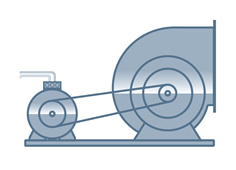BEATING THE HEAT IN DATA CENTRES (THE GREEN WAY)
)
In Singapore, studies done by the National Environment Agency in 2010 estimated that the total electrical energy usage of data centres is 3.6 percent of Singapore’s total electrical energy consumption. The energy consumption demand of data centre buildings is estimated to grow to 2,260 GWh by 2015, which is a 51 percent increase over 5 years. In 2020, these figures could only be even higher [2].
Real estate consultancy firm Cushman & Wakefield also ranked Singapore as the fifth most robust data centre market in the world, moving up one position up from 2020. It retained the top spot in the Asia Pacific region [3]. This suggests that energy consumption by data centres in Singapore has been increasing and will continue to increase in the years to come.
There are many reasons as to why energy consumption in data centres is at an all-time high. Trends such as 5G, Industry 4.0, mobile internet and internet TV have led to an ever-increasing demand for data. This in turn has led to a constant need to upgrade equipment and expand data centres. In addition, instant retrieval and access of data have now become a default expectation. As a result, data centres have to be in constant operation. Therefore, it is of no surprise that data centres expend large amounts of energy and generate an immense amount of heat at the same time. In fact, ventilation systems can account for up to 35 percent of energy use in data centres and energy used by fans contributes to a large portion of this statistic.
There are many ways to ventilate a data centre (Fig. 1). As there is no standard in the design of data centres, the design of ventilation systems within them vary as well.

Fig. 1. Ventilation systems in a data center
FACILITY COOLING
In the FanGrid configuration (Fig. 2), multiple centrifugal fans operate in parallel ensure the necessary inflow with a high level of efficiency.

Fig. 2. Centrifugal fans in FanGrid
Powerful and efficient axial fans that operate in parallel are the perfect choice for the controlled exhaust (Fig. 3). Diffusers can be mounted to provide an additional reduction in noise levels and higher efficiency.

Fig. 3. Axial fans in FanGrid
SERVER RACK COOLING
Powerful compact fans, typically available in axial, centrifugal or diagonal configurations, are used to keep server racks cool (Fig.4).

Fig. 4. Compact fans in server rack (Photo | BAHNHOF)
AREA COOLING
For data centres in particular, fans on condensers have a high duty cycle. They are usually found in data centres of various sizes.
In area cooling, Computer-Room Air-Conditioning (CRAC) units (Fig. 5) are of particular importance. CRAC units should be capable of maintaining constant temperature and humidity levels. Ideally, they should also be energy efficient, so as to reduce costs in operations.

Fig. 5. Centrifugal fans in CRAC Unit
But wait – there’s more. Keeping the (often sensitive) information stored in these centres secure is of utmost importance. In the 1940s, data centres mainly housed information that was military in nature. Nowadays, the type of information stored has expanded to encompass all other facets of life.
For data centre owners, losing any amount of data can be devastating. This can occur in a multitude of ways, such as security breaches or the overheating and subsequent spoiling of equipment. Therefore, reliable ventilation equipment is of paramount importance.
CONVENTIONAL FAN DESIGN & ALTERNATING CURRENT (AC) MOTORS
In older data centres, AC belt-driven fans (Fig. 6) are used. Belt-driven fans, however, are susceptible to the accumulation of dirt particles. While filters can lessen the impact, this then leads to the need for constant maintenance, where old belts and filters are replaced with new ones.

Fig. 6: AC belt-driven fan
New technologies, such as the fans from ebm-papst, are able to resolve such issues and improve energy efficiency at the same time.
EC technology is the latest motor technology available that can meet the high efficiency standards of today. EC motors have a higher performance that spreads across a wider operating point. In contrast with traditional AC motors, they are extremely efficient, especially at reduced speeds.
The EC fan comprises of an integrated system (Fig. 7). It contains (a) conversion electronics, (b) speed control electronics, (c) stator and (d) rotor. There are a few reasons why EC technology saves more energy as compared to AC.

Fig. 7. EC motor & electronics
Soft-Start (Fig. 8): When switching an AC motor on, it reaches its peak power rating before tapering off to the desired power level. In contrast, for EC motors, a soft-start occurs before it elevates to the desired power level.

Fig.8. Soft Start Graph
Variable Speed Control (Fig. 9): In AC motors, there are limited speed settings. This results in energy use that is not necessary. In contrast, EC motors can regulate energy use based on the conditions of the environment, resulting in improvement in energy efficiency.

Fig.9. Variable Speed Control Graph
An immense amount of research and development was necessary to develop these efficient technologies. Refinement in other aspects of the fan, such as the impeller, further improves the performance and thus efficiency of the equipment.
The combination of all of these factors in EC fans (Fig. 10) thus results in much lower energy use compared to conventional/AC ventilation equipment.
BUNKER TURNED FORTIFIED DATA STORAGE
Thirty meters beneath Stockholm’s tranquil Södermalm district is one of the most secure – and extraordinary – data centres in the world. In a retired fallout shelter called Pionen, data centre operator BAHNHOF stores its customers’ data behind steel doors that are 50 centimetres thick.
Previously, this James-Bond-inspired data centre utilised inefficient belt-driven AC fans in their CRAC units. ebm-papst Sweden was tasked to modernise Pionen’s ventilation system.
In the upgrade, the CRAC units were retrofitted with ebm-papst EC centrifugal fans, also known as the RadiCal (Fig. 10). These are low pressure fans with backward-curved blades.

Fig.10. RadiCal EC Centrifugal Fan
In total, the upgrade saved BAHNHOF 275 megawatt-hours of energy annually. It spends about 40,000 euros less on its annual electricity bill. In addition, there is no longer a need to conduct frequent maintenance as the EC fans do not use a belt-driven system. With this upgrade, not only did BAHNHOF save on operation costs, they also took a step forward in keeping their operations as eco-friendly as possible.
References
[1] A. S. G. Andrae, “New perspectives on internet electricity use in 2030,” 30-Jun-2020. [Online]. Available: https://pisrt.org/psr-press/journals/easl-vol-3-issue-2-2020/new-perspectives-on-internet-electricity-use-in-2030/. [Accessed: 06-Aug-2021].
[2] National Environment Agency, “Data Centre Energy Efficiency Benchmarking,” Sep-2012. [Online]. Available: https://www.e2singapore.gov.sg/DATA/0/docs/Resources/NEA%20DC%20Energy%20Benchmarking%20Summary-%20Final%20Report%20(3).pdf. [Accessed: 06-Aug-2021]
[3] Cushman & Wakefield, “Data Center Global Market Comparison,” https://www.cushmanwakefield.com/, 22-Jan-2021. [Online]. Available: https://cushwake.cld.bz/2021-Data-Center-Global-Market-Comparison. [Accessed: 06-Aug-2021].


 Cloud & AI Infrastructure
Cloud & AI Infrastructure
 eCommerce Expo | DMEXCO ASIA
eCommerce Expo | DMEXCO ASIA

)
)
)
)
)
)
)
)
)
)
)
)
)
)
)
)
)
)
)
)
)
)
)
)
)
)
)
)
)
)
)
)
)
)
)
)
)
)
)
)
)
)
)
)
)
)
)
)
)
)
)
)
)
)
)
)
)
)
)
)
)
)
)
)
)
)
)
)
)
)
)
)
)
)
)
)
)
)
)
)
)
)
)
)
)
)
)
)
)
)
)
)
)
)
)
)
)
)
)
)
)
)
)
)
)
)
)
)
)
)
)
)
)
)
)
)
)
)
)
)
)
)
)
)
)
)
)
)
)
)
)
)
)
)
)
)
)
)
)
)
)
)
)
)
)
)
)
)
)
)
)
)
)
)
)
)
)
)
)
)